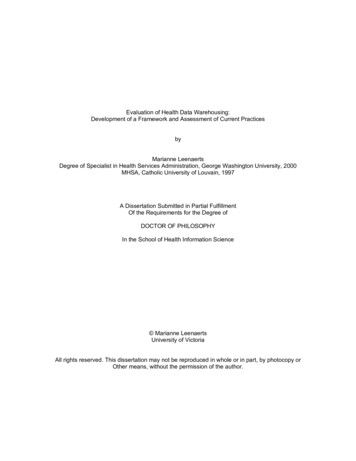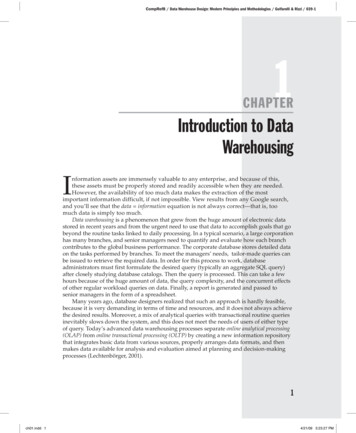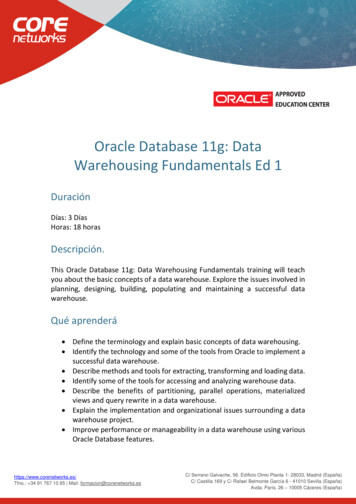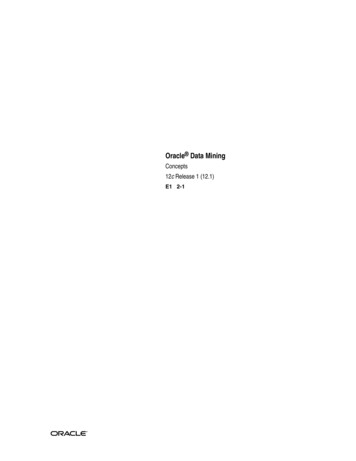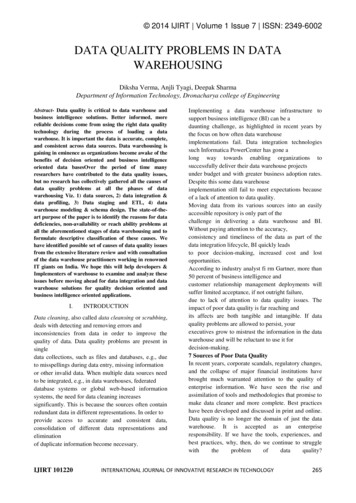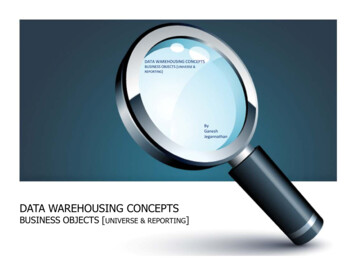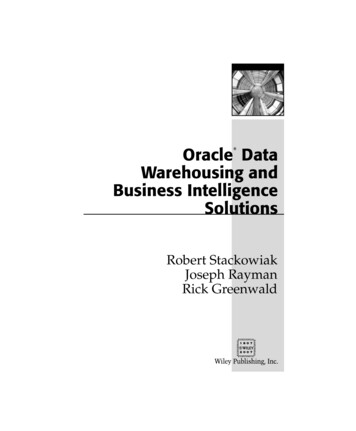
Transcription
01 919216 ffirs.qxp11/21/0610:28 PMPage iii Oracle DataWarehousing andBusiness IntelligenceSolutionsRobert StackowiakJoseph RaymanRick Greenwald
01 919216 ffirs.qxp11/21/0610:28 PMPage ii
01 919216 ffirs.qxp11/21/0610:28 PMPage i Oracle DataWarehousing andBusiness IntelligenceSolutions
01 919216 ffirs.qxp11/21/0610:28 PMPage ii
01 919216 ffirs.qxp11/21/0610:28 PMPage iii Oracle DataWarehousing andBusiness IntelligenceSolutionsRobert StackowiakJoseph RaymanRick Greenwald
01 919216 ffirs.qxp11/21/0610:28 PMPage ivOracle Data Warehousing and Business Intelligence SolutionsPublished byWiley Publishing, Inc.10475 Crosspoint BoulevardIndianapolis, IN 46256www.wiley.comCopyright 2007 by Wiley Publishing, Inc., Indianapolis, IndianaPublished simultaneously in CanadaISBN-13: 978-0-471-91921-6ISBN-10: 0-471-91921-7Manufactured in the United States of America10 9 8 7 6 5 4 3 2 11MA/RS/RS/QW/INNo part of this publication may be reproduced, stored in a retrieval system or transmittedin any form or by any means, electronic, mechanical, photocopying, recording, scanning orotherwise, except as permitted under Sections 107 or 108 of the 1976 United States Copyright Act, without either the prior written permission of the Publisher, or authorizationthrough payment of the appropriate per-copy fee to the Copyright Clearance Center, 222Rosewood Drive, Danvers, MA 01923, (978) 750-8400, fax (978) 646-8600. Requests to thePublisher for permission should be addressed to the Legal Department, Wiley Publishing,Inc., 10475 Crosspoint Blvd., Indianapolis, IN 46256, (317) 572-3447, fax (317) 572-4355, oronline at http://www.wiley.com/go/permissions.Limit of Liability/Disclaimer of Warranty: The publisher and the author make no representations or warranties with respect to the accuracy or completeness of the contents of thiswork and specifically disclaim all warranties, including without limitation warranties of fitness for a particular purpose. No warranty may be created or extended by sales or promotional materials. The advice and strategies contained herein may not be suitable for everysituation. This work is sold with the understanding that the publisher is not engaged in rendering legal, accounting, or other professional services. If professional assistance isrequired, the services of a competent professional person should be sought. Neither thepublisher nor the author shall be liable for damages arising herefrom. The fact that an organization or Website is referred to in this work as a citation and/or a potential source of further information does not mean that the author or the publisher endorses the informationthe organization or Website may provide or recommendations it may make. Further, readers should be aware that Internet Websites listed in this work may have changed or disappeared between when this work was written and when it is read.For general information on our other products and services or to obtain technical support,please contact our Customer Care Department within the U.S. at (800) 762-2974, outside theU.S. at (317) 572-3993 or fax (317) 572-4002.Library of Congress Cataloging-in-Publication Data: Available from publisher.Trademarks: Wiley, the Wiley logo, and related trade dress are trademarks or registeredtrademarks of John Wiley & Sons, Inc. and/or its affiliates, in the United States and othercountries, and may not be used without written permission. Oracle is a registered trademarkof Oracle Corporation. All other trademarks are the property of their respective owners.Wiley Publishing, Inc., is not associated with any product or vendor mentioned in this book.Wiley also publishes its books in a variety of electronic formats. Some content that appearsin print may not be available in electronic books.
01 919216 ffirs.qxp11/21/0610:28 PMPage vAbout the AuthorsRobert Stackowiak is Vice President of Business Intelligence in Oracle’sTechnology Business Unit. He has worked for over 20 years in businessintelligence, data warehousing, and IT-related roles at Oracle, IBM, HarrisCorporation, and the U.S. Army Corps of Engineers. His papers regardingbusiness intelligence and computer and software technology have appearedin publications such as President & CEO Magazine, Database Trends andApplications, and The Data Warehousing Institute’s publications. He alsoco-authored the books Oracle Essentials: Oracle Database 10g (currently in3rd Edition, February 2004, O’Reilly), Oracle Application Server 10g Essentials(1st Edition, August 2004, O’Reilly), and Professional Oracle Programming(1st Edition, June 2005, WROX).Joseph Rayman leads the Oracle Consulting Business Intelligence Practicein North America with over 20 years of business experience in a vast arrayof industries, including financial services, manufacturing, retail, telecommunications, healthcare, and federal government. His technical and business leadership spans enterprise architecture design, enterprise datamodeling, VLDB system tuning, data warehouse design, data mining, andquality assurance activities for data warehouse practices. Joe is a key contributor in defining and authoring Oracle Consulting’s Data WarehousingMethodology. Prior to joining Oracle, Joe designed and deployed businessintelligence and statistical analysis solutions for a large food manufacturerand provided real-time trading and analysis solutions for a major international financial organization.v
01 919216 ffirs.qxpvi11/21/0610:28 PMPage viAbout the AuthorsRick Greenwald has worked in the IT field for over 20 years for major vendors, including Oracle, Gupta Technologies, Cognos, and Data General. Hehas coauthored more than a dozen books, including Oracle Essentials: OracleDatabase 10g (currently in 3rd Edition, February 2004, O’Reilly), OracleApplication Server 10g Essentials (1st Edition, August 2004, O’Reilly), andProfessional Oracle Programming (1st Edition, June 2005, WROX). Mr. Greenwald currently works for Ingres Corporation.
01 919216 ffirs.qxp11/21/0610:28 PMPage viiCreditsExecutive EditorRobert ElliottProject CoordinatorAdrienne MartinezSenior Development EditorTom DinseGraphics and ProductionSpecialistsCarrie A. FosterStephanie D. JumperBarbara MooreHeather RyanAlicia B. SouthProduction EditorAngela SmithCopy EditorMichael KochEditorial ManagerMary Beth WakefieldProduction ManagerTim TateVice President and ExecutiveGroup PublisherRichard SwadleyVice President and ExecutivePublisherJoseph B. WikertQuality Control TechniciansJessica KramerBrian H. WallsBook ProofreadingTechbooksIndexingStephen IngleAnniversary Logo DesignRichard Pacificovii
01 919216 ffirs.qxp11/21/0610:28 PMPage viii
02 919216 ftoc.qxp11/21/0610:28 PMPage ixContentsAcknowledgmentsIntroductionxvxviiPart IOracle Business Intelligence Defined1Chapter 1Oracle Business IntelligenceBusiness Intelligence and Transactional Applications34Daily Business IntelligenceBalanced ScorecardEnterprise Planning and BudgetingActivity-Based ManagementOracle Integration Components Enabling Business IntelligenceData HubsBusiness Activity MonitoringBPEL Process ManagerEnterprise Messaging ServiceCustom Data Warehouse SolutionsThe Role of the Oracle DatabaseOracle Warehouse BuilderOracle Business Intelligence Standard EditionOracle Business Intelligence Enterprise EditionBI (XML) PublisherOracle PortalSpreadsheet Add-insBuilding Custom Business Intelligence ApplicationsEmerging Trends568991010111112141516182020212324ix
02 919216 ftoc.qxpx11/21/0610:28 PMPage xContentsChapter 2Oracle’s Transactional Business IntelligenceTransactional Business IntelligenceBusiness TerminologyOracle’s Daily Business Intelligence3334Balanced Scorecards45Data HubsThe Oracle Customer Data HubHow Data Hubs WorkOther Oracle Data Hubs46484849495151Is Transactional Business Intelligence Enough?52Introduction to Oracle Data WarehousingOracle Data Warehousing Basics5354Oracle Database Analysis and Schema ConsiderationsManaging an Oracle-based Data WarehouseWhere to Start?Oracle/PeopleSoft EPMOracle/Siebel Business Analytics ApplicationsChoosing Completely CustomChapter 42830How DBI WorksVarieties of DBIOracle Balanced Scorecard StructureOBSC ArchitectureCreating an Oracle Balanced ScorecardChapter 32728Choosing a PlatformScaling Up Platforms Versus Scaling OutHardware PlatformsCost ConsiderationsAvailability ConsiderationsManageability ConsiderationsSizing the PlatformInformation Needed for Warehouse Hardware SizingBenchmarkingSizing Hardware for Business Intelligence Tools55647071737475767780808384858689Your Strategy90Part IICustom-Built Data Warehousing Solutions91Chapter 5Designing for UsabilityApproaches for Design9394Key Design ConsiderationsFeatures for Design — Enhancing PerformanceBusiness ScenarioNormalized DesignDimensional DesignHybrid Design9498106108110113
02 919216 ftoc.qxp11/21/0610:28 PMPage xiContentsOnline Analytical Processing DesignOther ConsiderationsChapter 6Selecting the Best Approach126Business Intelligence ToolsOracle Portal and Portal Products127128Using Oracle PortalBuilding and Deploying Oracle Portal and PortletsReportingBI/XML PublisherOracle ReportsOracle BI Reporting Workbench (Actuate)Ad hoc Query and AnalysisBusiness Intelligence Enterprise EditionDiscoverer and Business Intelligence Standard EditionOracle Spreadsheet Add-insBuilding Business Intelligence ApplicationsJDeveloper and BI BeansData MinerChapter 7136137140141142143153162165166166169Data LoadingOracle Database Data Loading Features175176Embedded ETL in the Oracle DatabaseSQL*LoaderChange Data CaptureTransportable TablespacesData Pump177178179180180181OWB PackagingTypical Steps when using OWBETL Design in OWBOWB and Dimensional ModelsThe OWB Process Editor181182184189191Balancing Data Loading Choices192Managing the Oracle Data WarehouseOracle Enterprise Manager Grid Control195196Database Performance MonitoringDatabase AdministrationDatabase MaintenanceDatabase TopologyChapter 9129132Other ToolsOracle Warehouse BuilderChapter 8116120200202218223Management and Management Options224Data Warehouse Performance Tuning and MonitoringUnderstanding Performance Challenges227228Who Is Responsible?Causes of Poor Performance228231xi
02 919216 ftoc.qxpxii11/21/0610:28 PMPage xiiContentsSuccessful Approaches to Performance Tuning239244247256Business Scenario: Tuning Our Sample Solution257Where To StartEnterprise Manager Advisory FrameworkApproaches for SuccessPart III238Critical Tasks for Performance Tuning LifecycleHardware ConfigurationSoftware ConfigurationDatabase Application DesignBest PracticesChapter 10 Scoping the Effort and an Approach for SuccessUncovering Key Business InitiativesWhere to StartInformation SourcesWhat is ImportantAccountability and Securing Business SponsorshipEstablish a Steering CommitteeProject Review BoardEndorsing a MethodologyChoices of MethodologiesA Business-focused ApproachStaffing the ProjectOrganization StructureEnd-User ExperienceEngaging the Business: Education and TrainingManaging RiskCommunication — Managing ExpectationsContingency AllocationFinancial RiskTechnology RiskNo Place to ShortcutChapter 11 Understanding Business NeedsHow Bad Deployment Choices Impact the BusinessIndependent Data MartsLimited and Inflexible ReportingSources of Information Limited to Internal DataLimited Data HistoryLack of Current High-Quality DataLimited Growth FlexibilityProject Drivers and Business TypesFinancial CompaniesHealthcareManufacturingMedia and 311311312313314314316318319
02 919216 ftoc.qxp11/21/0610:28 PMPage xiiiContentsRetailTelecommunicationsOther Business Types: Transportation and UtilitiesEducational InstitutionsGovernment AgenciesDeveloping Scope and Gaining Business SupportChapter 12 Justifying Projects and Claiming SuccessConcept to ProjectBusiness ConstraintsWhere to Start JustificationMeasuring ValueCommon Metrics to MeasureCommon Budgeting TechniquesTotal Cost of OwnershipModeling Total Cost of OwnershipReturn on InvestmentModeling Return on InvestmentClaiming 9356357360360363365xiii
02 919216 ftoc.qxp11/21/0610:28 PMPage xiv
03 919216 flast.qxp11/21/0610:01 PMPage xvAcknowledgmentsWe begin by acknowledging the support of our families, especially ourwives who realize that authors sometimes get a bit cranky and difficult asdeadlines approach. Although they probably hope there is not another bookcoming from any one of us soon, we realize such an undertaking would notbe possible without the support of Jodie Stackowiak, Donna Rayman, andLuAnn Greenwald.Special thanks to the folks at Wiley Publishing who worked their magicto turn the documents and screen-captured images from our laptops intothe book you have in front of you. We would especially like to thank TomDinse, our Senior Development Editor, and Bob Elliott, Wiley’s ExecutiveEditor who understood the need for such a book.Within Oracle, we have had the great fortune to work with many peopleskilled in this area. From Oracle Development, we would like to acknowledge the following who have provided us with guidance over the yearsthat was especially relevant for this book: George Lumpkin, Robert Ash,Hermann Baer, Andrew Holdsworth, Paul Narth, Jean-Pierre Dijcks, PaulRodwick, Chris Leone, and Ray Roccaforte. We would also like to acknowledge the contributions of business intelligence specialists in the TechnologyBusiness Unit, especially Louis Nagode, Gayl Czaplicki, Derrick Cameron,Jim Bienski, Alan Manewitz, Joan Maiorana, and the Enterprise Technology Center under Jim Olsen where we were able to illustrate some of thelarge-scale management capabilities.xv
03 919216 flast.qxpxvi11/21/0610:01 PMPage xviAcknowledgmentsOracle also has a great many business intelligence specialists within sales,consulting, and other organizations around the world who remind us ofthe day-to-day challenges that their customers face when building thesesolutions. Some of the key individuals who influenced the content in thisbook include David Pryor, Susan Cook, Steve Illingworth, Nick Whitehead,Jon Ainsworth, Kevin Lancaster, Craig Terry, Joe Thomas, Rob Reynolds,Rich Solari, Nuge Ajouz, Ken McMullen, Brian MacDonald, and PatrickViau. There are many more, of course.Lastly, much of the content in this book is based on the experience of theauthors. Some of the descriptions of what to avoid are based on observations we made of less successful techniques used by Oracle’s customers.But many of Oracle’s customers and partners provide innovation and techniques that take product features and turn them into useful solutions. Wehave had the fortune of dealing with both types of customers, and thisbook is much stronger and realistic because of what these customers andthe Oracle partners have shared with us. So, thank you to all of you whomwe have worked with over the years. We especially hope you find thisbook to be of value as you build and develop your own solutions.
03 919216 flast.qxp11/21/0610:01 PMPage xviiIntroductionWe are now decades into deploying decision support systems, data warehouses, and business intelligence solutions. Today, there are many booksthat describe data warehousing and design approaches. There are manybooks that describe business intelligence. There are many books thatdescribe the Oracle database. So you may be asking, why did the authorsdecide to write this book?The fact is, the authors of this book still hear comments from many ofyou that business intelligence and data warehousing projects are problematic. This seems to be true regardless of database technologies or businessintelligence tools selected and deployed. While the wealth of Oracle skillsand resources that exist might make this less true where Oracle technologyis part of the solution, the number of implementations that face significantissues and the repetition of mistakes convinced the authors that too fewprojects are approached holistically. Not many of the books that are available as resources look at Oracle business intelligence and data warehousing in such a manner.This book attempts to give you a single reference that covers a diverserange of relevant topics in providing a holistic approach. It covers the database and platform technology, of course. But it also covers business intelligence tools, emerging business intelligence applications, architecture choices,schema selection, management and performance tuning, requirementsgathering, and justifying the project. Tips are included throughout the bookbased on real experience and implementations.xvii
03 919216 flast.qxp11/21/0610:01 PMPage xviiixviii IntroductionYour tendency might be to jump to sections you know something aboutor suspect as being a possible solution to a problem in order to furtherdevelop your knowledge of a specific topic. Although you should findvalue in using this book that way, keep in mind that the reason many implementations struggle is due to ignoring areas that should be understood andare outside the core competencies of those engaged in the project.To sum it up, the goal of this book is more than about gaining academicknowledge. If this book attains its objective, you will gain knowledge thatyou can apply to your own project such that your deployed solution will beviewed as successful technically within Information Technology (IT), butalso successful because it delivers the business value that your businesscommunity recognizes.Who This Book Is ForThis book should appeal to a wide audience. Although those in IT will findit particularly useful, more technically inclined business analysts and managers should also find value in topics such as justifying projects and evaluating deployment choices.Within IT, the day-to-day management and modification of such aninfrastructure often falls on database administrators, programmers, andsystems managers. Certainly, we cover topics of interest to this group.Unfortunately, the value of architects and project managers in deployingand updating such solutions is often overlooked. There is plenty in thisbook that should also appeal to that audience.How This Book Is OrganizedThis book is divided into three parts:Oracle Business Intelligence DefinedCustom Built Data Warehousing SolutionsBest PracticesPart I: Oracle Business Intelligence DefinedPart I provides a broad background as to possible Oracle-based solutionsand how you might deploy them. The database and business intelligencetools are introduced here, but other related topics are covered as well in thefollowing four chapters.
03 919216 flast.qxp11/21/0610:01 PMPage xixIntroductionChapter 1: Oracle Business IntelligenceA broad introduction of Oracle business intelligence is provided. Topicsintroduced include Oracle’s transactional business intelligence, integrationcomponents, and components in custom-built data warehouses and business intelligence solutions.Chapter 2: Oracle’s Transactional Business IntelligenceSometimes called operational business intelligence, this chapter describesOracle’s Daily Business Intelligence modules, Balanced Scorecard solution,and Data Hubs (used in master data management). You are provided withguidance as to where such solutions might be particularly useful and whya data warehouse might also be deployed to augment such a solution.Chapter 3: Introduction to Oracle Data WarehousingThe introduction of this topic covers the wide array of features in the Oracle database that are relevant in data warehousing. More detailed explanations are provided in Part II of this book. In addition, the chapter covers thedata models that Oracle provides for its applications as pre-built datawarehousing solutions.Chapter 4: Choosing a PlatformThe basics of choosing a hardware platform are covered including scalingup versus scaling out and how to size your choice. Specifics addressedunder these broad topics include high availability considerations, manageability considerations, and approaches to benchmarking.Part II: Custom-Built Data Warehousing SolutionsMost business intelligence solutions today are custom built. Part IIdescribes design approaches and deploying and managing business intelligence tools and an Oracle data warehousing database. These areexplained in the following five chapters.Chapter 5: Designing for UsabilityCovering approaches to design, topics in this chapter include how to leverageOracle features and an illustration of how these features can be used to provide solutions to needs driven by a business scenario. Schema approachesare described including third normal form, star schema, hybrids, andOnline Analytical Processing (OLAP).xix
03 919216 flast.qxpxx11/21/0610:01 PMPage xxIntroductionChapter 6: Business Intelligence ToolsThis chapter introduces using and deploying Oracle’s wide array of business intelligence tools, including portals, reporting, and ad hoc query andanalysis tools. The Oracle Business Intelligence Suites (Standard Editionand Enterprise Edition) are covered. In addition, the Oracle database support provided by business intelligence tools available from other vendorsis described.Chapter 7: Data LoadingEmbedded extraction, transformation, and loading (ETL) features providedby the Oracle database are described in this chapter. Oracle WarehouseBuilder’s role in ETL, target data warehouse design, data quality analyses,and metadata management is also described.Chapter 8: Managing the Oracle Data WarehouseOracle Enterprise Manager provides a useful interface often used in managing Oracle data warehouses as described in this chapter. The Grid Controlinterface for managing clusters is illustrated, as are interfaces for basic performance monitoring, administration, and maintenance.Chapter 9: Data Warehouse Performance Tuning and MonitoringTypical performance challenges are described and proven approaches tosolving such challenges are presented. We then illustrate using suchapproaches to tune the data warehouse first described in the business scenario presented in Chapter 5.Part III: Best PracticesUnderstanding the technology is great, but is no guarantee of success. PartIII will help you identify potential risk and best approaches for mitigatingrisk as you develop and deploy your solution. These best practices aredescribed in the following three chapters:Chapter 10: Scoping the Effort and an Approach for SuccessThis chapter describes how to uncover initiatives by your business community, securing business sponsorship, endorsing a methodology, projectstaffing, and managing risk.
03 919216 flast.qxp11/21/0610:01 PMPage xxiIntroductionChapter 11: Understanding Business NeedsBusiness needs for better business intelligence might be driven by a poorlydesigned solution or by a new business requirement. Examples of less optimal solutions and how they can impact the business are first described inthis chapter. Typical project drivers driven by business requirements are thenpresented followed by suggestions on how to build support for a project.Chapter 12: Justifying Projects and Claiming SuccessGetting the go-ahead to build a solution often requires financial justification. This chapter identifies the potential costs you should consider andwhere business benefits might come from. Financial benefits are computedfor a variety of scenarios and computing return on investment (ROI) isdescribed.Illustrations in the TextOracle product illustrations in the text are captured from recent Oraclesoftware versions. You should be able to leverage similar capabilitiesregardless of your Oracle software version provided you have Oracle Database 10g, Oracle Business Intelligence 10g, or newer releases of these products. We frequently indicate when key features were introduced in theseproducts so that if you have older releases deployed, you can understandlimitations you might face.From HereTo become an expert on this topic usually requires years of practice andlearning, implementations for a variety of companies and organizations,and the uncommon ability to feel equally at home discussing needs anddetails among both IT and business co-workers. For those that grow insuch expertise, there is great opportunity and potential reward.This book is intended to help lay that foundation. Of course, your success will depend not only on what you read in the following chapters, butalso on how you put what you learn here into practice in the solutions youwork on. As you now start reading this book, it is our hope that it will helpyou avoid many common pitfalls and that you will gain a better perspective on how to attain professional success in building and deploying suchprojects.xxi
03 919216 flast.qxp11/21/0610:01 PMPage xxii
04 919216 pt01.qxp11/21/0610:02 PMPage 1PA R TIOracle BusinessIntelligence DefinedIn This PartChapter 1: Oracle Business IntelligenceChapter 2: Oracle’s Transactional Business IntelligenceChapter 3: Introduction to Oracle Data WarehousingChapter 4: Choosing a Platform
04 919216 pt01.qxp11/21/0610:02 PMPage 2
05 919216 ch01.qxp11/21/069:59 PMPage 3CHAPTER1Oracle Business IntelligenceBusiness intelligence can be defined as having the right access to the rightdata or information needed to make the right business decisions at theright time. The data might be raw or might have been analyzed in someway. Having access to such information enables management of the business by fact instead of by primarily relying on intuition.This is a broad definition of business intelligence and is not limited todata warehousing alone. Although a data warehouse is often used to provide such a solution and is the primary focus of most of this book, we’llbroaden the discussion to also include business intelligence gained fromon-line transaction processing solutions. Business analysts and users ofbusiness intelligence don’t really care about — or want to understandwhere their information comes from. They simply want access to suchsources. So the solution you choose to deploy will depend on the kind ofinformation that is needed.This chapter provides a broad discussion of Oracle’s business intelligence offerings and should help you better understand all of the solutiontypes available for deployment. We conclude this chapter by discussingsome of the emerging business needs that will lead to a further blending ofdata warehousing and transactional systems. In subsequent chapters inthis section of the book, we provide more details as to how and why you’d3
05 919216 ch01.qxp411/21/06Part I 9:59 PMPage 4Oracle Business Intelligence Defineddeploy transactional business intelligence and data warehousing solutions. We also discuss some of the platform strategies for deployment.After the introductory first section of this book, we describe in muchgreater detail the area of business intelligence that you are probably mostinterested in: custom-built data warehousing solutions using Oracledatabases. We provide examples of how you can design, use, and managevarious capabilities of the Oracle database and Oracle business intelligencetools. In the final section of this book, we discuss best practices and strategies for deployment of such solutions.Although the primary audience of the book is information technology(IT) professionals, we begin this book with the following warning: building a business intelligence solution as an IT project without sponsorship ofor buy-in by the lines of business is likely to end in very limited success orcareer-limiting failure. For many of you, the non-technical portions of thisbook in the best practices section might initially be of the least interest,because your interest is centered in IT and implementing technology platform solutions. However, applying techniques described in that sectioncould determine whether your project is viewed as successful.Business Intelligence andTransactional ApplicationsTransactional applications generally provide business intelligence to business users through reports that reveal current data in transactional tables.Oracle’s E-Business Suite of applications, PeopleSoft applications, JDEdwards applications, and Siebel Customer Relationship Managementapplications all provide this level of business intelligence. Reporting isselected and deployed based on key business requirements (KBRs) andmost commonly displayed as key performance indicators (KPIs) in a dashboard using portal technology.Most companies also deploy business intelligence solutions that rely on acomplementary data warehousing strategy when reporting and analysisbecomes more complex and summary level information is appropriate.Oracle’s PeopleSoft and JD Edwards’ EnterpriseOne applications are oftensurrounded by the PeopleSoft Enterprise Performance Management (EPM)data warehouse to enable such reporting through analytical applications.Oracle’s Siebel Customer Relationship Management (CRM) applicationsare similarly often surrounded by Business Analytics Applications builtupon a relationship management warehouse model. Other application vendors (such as SAP with their Business Warehouse) have such data warehouse models that often are deployed on Oracle databases.
05 919216 ch01.qxp11/21/069:59 PMPage 5Chapter 1 Oracle Business IntelligenceThe Oracle E-Business Suite leverages more of a blended approach todelivering business intelligence applications as many of these applicationsrely on data in summary levels of transactional tables. The Enterprise Planning and Budgeting application, a more complex analytical application,leverages Oracle OLAP technology in a separate multi-dimensional cube.At the time of publication of this book, Oracle has described manyaspects of Project Fusion, Oracle’s future single set of transactional applications that provide a migration path for current deployments of theE-Business Suite, PeopleSoft, JD Edwards, and Siebel CRM applications.The business intelligence solutions provided for t
Oracle Business Intelligence Enterprise Edition 18 BI (XML) Publisher 20 Oracle Portal 20 . 02_919216 ftoc.qxp 11/21/06 10:28 PM Page ix. Chapter 2 Oracle's Transactional Business Intelligence 27 Transactional Business Intelligence 28 Business Terminology 28 Oracle's Daily Business Intelligence 30 How DBI Works 33 Varieties of DBI 34 .

